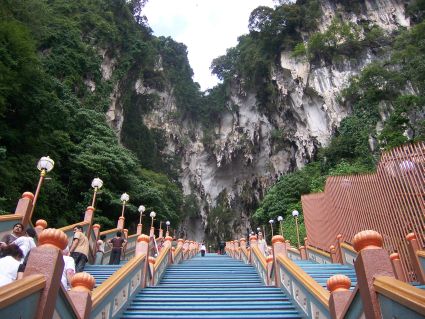You are currently browsing the tag archive for the ‘Culture’ tag.
Batu Caves ROCKS! Well…at least that’s how I felt of my recent visit to the site. The last time I visited Batu Caves was about 20 years ago! Except for some religious purposes (for the Hindus) there was nothing really one could do at Batu Caves back then… other than to look at and admire some of the odd and unique rock formations. So when some friends invited me for a half-day ‘excursion’ to Batu Caves recently, I went along because I wanted to see how much Batu Caves has changed.
When we arrived at the main gate of the Batu Caves complex, we were ‘greeted’ by a tall golden statue of Lord Murugan.
Standing at 43meter (135 feet) this is claimed to be the tallest statue of Lord Murugan in the world!
Completed in January 2006, the statue cost RM 2.6 million to build and used 1,550 cubic metre of concrete and 300 litres of gold paint.
Now…to reach the main cave, which is popularly referred to as the ‘cathedral cave’, one needs to climb up those 272 steps. But not to worry, the view one gets as one goes higher is worth the climb! Tired? Loosing the breath? Well…take a break! Sit on the step and enjoy the scenery:)
The last time I was here I could not enjoy this luxury:( It was on a Thaipusam day and there were millions of people (devotees and curious visitors like myself) climbing those steps… all at the same time! I did not even have to ‘try’ to climb…I was literally ‘pushed’ from the 1st step on the ground all the way to the final step on the top… by the crowd! Talk about good ‘vibes’ and ‘energy’…:)
Located at the top of the staircase is actually the main cave.
My friends and I continued venturing deeper into the cave.
The cave formations were really wonderful. Long stalactites hanging down from the ceiling. Stumpy stalagmites rising up from the floor.
I was also informed that these stalactites and stalagmites were indeed still very much alive! And growing! Whoa!
It is also claimed that the rock forming the cave is actually 400 million years old! Indeed, I was told that the cave itself is about 60-100 years old. But the most fascinating fact I found was that the limestone rock (of the cave) was originally formed from layers of shells and corals once UNDER the sea! They were then uplifted into hills and mountains!
We also found a strange looking rock formation at the most end side of the main cave. Strangely enough, this unique shaped rock (…or rather stalactite) remind me of my trip to Koh Sa Mui in Thailand. Over there I found a rock formation which was almost similar to the one in Batu Cave. The only difference is… Koh Sa Mui’s rock stood erected by the sea while this one in Batu Cave was found hanging down from the ceiling…
Now… compare with these photos I took @ Koh Sa Mui, Thailand…
We ended our day at the Batu Cave with a stop at a small cafe located in the complex.
I ordered a cup of ‘teh tarik’ (tea with milk – done in a very ‘Malaysian’ style) and … soon after I found myself ordering another cup of the same thing! The reason? That was the best ‘teh-tarik’ I’ve ever tasted in Kuala Lumpur… ever!
On the way out, we came upon a group of people actively participating in rock climbing activities. Well… this only proved that there are actually lot of things one can see and do when visiting Batu Caves nowadays. Cave exploration, rock climbing, nature walk-about … just to name a few. And of course, on a Thaipusam day, you can watch the colorful and fascinating ‘kavadi’ parade too.
So… if you visit Kuala Lumpur I would recommend you to include Batu Caves in your ’10 Things Must See in KL’ list simply because… Batu Caves ROCKS!
Niah in Sarawak, Malaysia and the Nile of Egypt…two places which are vastly separated by lands, seas, cultures, traditions and peoples. And yet, when I visited Egypt not so long time ago I was astonished to find one obvious similarity in the ancient traditions of these two exotic lands…the burial ceremony of their loved ones… the ritual performed onto those ‘lovely bones‘ of the deceased dwellers of Niah and the Nile.

The wall paintings found in the Painted Cave of Niah depicting the boat journey of the dead into the afterlife. A feature in traditions shared by both the dwellers of Niah and the Nile...?
I had actually paid a visit to Niah some years prior to my holiday in Egypt. Back then, Niah was not as popular as a tourist destination as it is now. Hence, it was not a ‘smooth sailing’ event for me to get there. From Miri town (distance-110km) I had to take a bus to a place referred to as ‘Niah Rest Stop’. It was located on the Miri to Bintulu road. There was no direct bus from Miri (or even from Bintulu – distance:131km) to Niah then.

Niah Cave has 8 entrances - the biggest is the west entrance, also known as the 'WEST MOUTH' - one of the world's most spectacular cave entrances!
From ‘Niah Rest Stop’ I then hopped into a minibus to take me to the Niah Park Headquarter located in a place called Pengkalan Batu (about 3 km from Niah). I had to pay RM10 for the Park’s Entrance Fee (only RM5 for Child) and another RM5 for Camera Permit (and RM10 if you take a videocam with you).
 Now…to get to the cave, I had to take a small motorized ‘sampan’ to cross the Niah River.
Now…to get to the cave, I had to take a small motorized ‘sampan’ to cross the Niah River.
Cost only RM1 per pax then. Not sure how much it costs now.
 After safely reached the other side of the river’s bank, I then I continued walking the 3km plank-walkway. The raised plank-way was built above a dark forest swamp and cut through a dense tropical rainforest.
After safely reached the other side of the river’s bank, I then I continued walking the 3km plank-walkway. The raised plank-way was built above a dark forest swamp and cut through a dense tropical rainforest.
 Upon finally reaching a cliff, the path started to ‘climb’. It looke like a ‘tunnel’ to me. Soon enough, the ‘tunnel’ opened up into the great ‘Dragon Mouth’… or better known as the West Mouth of the Niah Cave Complex.
Upon finally reaching a cliff, the path started to ‘climb’. It looke like a ‘tunnel’ to me. Soon enough, the ‘tunnel’ opened up into the great ‘Dragon Mouth’… or better known as the West Mouth of the Niah Cave Complex.
The West Mouth is 60m high and 250m wide! It is indeed one of the world’s MOST spectacular cave entrance! It is believed that about 40,000 years ago the cave was populated by prehistoric men. To be precise… the dwellers were of the Paleolithic times (the earliest part of the Stone Age). Indeed, they were believed to be the earliest human in the South East Asia region!
 Today the caves remain important for locals for their birdnests and guano (bat & bird manures/faeces) collection. The birdsnest collectors use bamboo poles and ladders made from Belian wood (ironwood) to climb to the cave’s ceilings. It is believed that there are about 1/2 million swiflets live in the caves!
Today the caves remain important for locals for their birdnests and guano (bat & bird manures/faeces) collection. The birdsnest collectors use bamboo poles and ladders made from Belian wood (ironwood) to climb to the cave’s ceilings. It is believed that there are about 1/2 million swiflets live in the caves!
 Leaving the main cave behind, i then continued to the next ‘attraction’ – the ‘Painted Cave’. I had to pass through another cave called ‘Moon Cave’, walked in almost total darkness for awhile before emerging into daylight. A short trail followed and before I knew it, I was already standing inside the ‘Painted Cave’.
Leaving the main cave behind, i then continued to the next ‘attraction’ – the ‘Painted Cave’. I had to pass through another cave called ‘Moon Cave’, walked in almost total darkness for awhile before emerging into daylight. A short trail followed and before I knew it, I was already standing inside the ‘Painted Cave’.
‘Painted Cave’ houses wall-paintings depicting the boat journey of the dead into the afterlife. The site is believed to be the burial sites of people of the Paleolithic and Neolithic times. Set on the cave wall were numerous paintings of ‘boats’ loaded with up to 20 people. Some crumbling dug-out canoes, which had acted as coffins, were also placed against the wall of the cave.
Back then, I had not paid that much attention to the significant of those paintings and ‘death canoes’. And it never crossed my mind that I would be seeing something similar in places thousand of miles apart and some seas away from this humble cave of Niah. The ancient people of these two places seemed to have had shared the same ritual in putting the ‘lovely bones‘ of their loved ones to rest. And…’that’ other place I meant was no other than … the land of pyramids, pharaohs and the Nile… Egypt!
…of Niah & Nile
QUICKIES
There are now direct buses to Batu Niah from Miri and Bintulu…
Miri – from the Miri Bus Station – ‘quite’ regular – 1 hr to 2 hrs journey time
Bintulu – from the Bintulu Bus Station – 2 to 3 hrs journey time
Batu Niah to Niah HQ (Pengkalan Batu) – there are 3 alternatives:
1) motorized boat
2) taxi
3) walking – 45″ stroll along the riverbank
The Niah Cave Park opens from 8am to 5pm.

- Fascinating fishing villages of RIAU
Riau Archipelago was once THE heartland of the Malays of the Malay Archipelago region. Indeed, it was here that the 1st ever book of Malay Grammar , the ‘Bustanul Katibin’ was written & published in 1857. So, it is not surprising to know that this beautiful region is indeed the cradle of Indonesia’s Malay-based national language & culture.

'Silat' - Malay art of self-defense
So with that thought on mind, I decided to take a ‘peek’ at this fascinating clutters of edens. Accompanied by a dear friend from the Philippines, I started my ‘Malay soul-searching’ trip by boarding a boat from Setualang Laut, Johor, Malaysia heading to Batu Ampar Port of Batam. Batam is the nearest island of the Riau Archipelago to Malaysian & Singaporean shores. The one-way boat ride cost RM56 (including Port Tax).
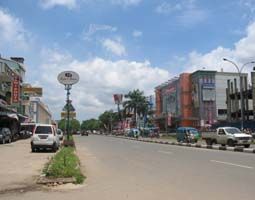
Nagoya Town, BATAM.
From the port, we hopped onto two ‘motorbike taxis’ and headed straight to Nagoya Town. RP5000 for the ride. We then went to look for a room and finally settled with a small, clean room located right in the heart of the town. After few hours of going around town, I then decided that I did’nt really fancy Batam at all! Batam to me is nothing more than a ‘playground’ for Singaporean (and some Malaysian too, I suppose). Of course, due to its strategic proximity to Singapore, Batam has also been designated as a centre of industry and trade for the region. Whatever. Truth was, I couldnt wait to get out of Batam at the soonest possible time and to continue exploring further into the very heart of the Riau Archipelago… and maybe even try to go beyond that.

The main jetty of Tanjung Pinang, BINTAN Island, RIAU.
So, early next morning, we took a cab to Telaga Punggur Port. The cab ride cost us RP30,000. We hopped into a boat and about 1 hour later we were already at the Tanjung Pinang Jetty of Bintan Island. I immediately liked what I saw and knew that we had made a good decision:)

Interesting crowd on main street of Tanjung Pinang town of BINTAN
Tanjung Pinang on Bintan Island is a busy little town. A large section of the old port of this town was built in traditional local style – on stilts, over the water. Nice!
We took our own ‘sweet-time’ and enjoyed the ‘energy’ of the town. We had tea at a nice roadside kiosk and chatted with some locals. They were very friendly and helpful indeed. Well, we even managed to get some ‘tips’ on good accommodation on the island!

eSa & friend @ Tanjung Pinang Corniche. The rest-house where we stayed in was located on top of the hill in the background of this photo. A room with a view... awesome view, indeed!
We decided to stay at an old rest-house located on top of a hill overlooking the sea & part of Tanjung Pinang town.
The view from the room’s balcony was AWESOME! We could clearly see the Penyengat Island and its famous landmark, the bright yellow color building of the Sultan Masjid.
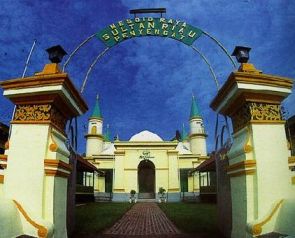
The Sultan masjid of Penyengat Island. Some locals claimed that in the past, the 'masjid' was painted bright yellow by using egg-yolks! Whoa! How much egg-yolks do you think they had to use in order to achieve that effect? Awesome!
The next day, we took a small ‘sampan’ (a small sailing vessel) and sailed across to Penyengat Island. Cost us only RP5,000. The very first thing I noticed when I stepped onto the island: the whole place was sparkling clean! Really! I was impressed:)

eSa with 'beautiful souls' of Penyengat Island
And then… oh those children! Runing around everywhere with their bright smiles and warm greetings. ‘Assalamualaikum’ (Muslim greeting) was heard over and over again… in every nook & corner that we went.
Well, we were even invited by a middle-aged woman and her children to join them for a feast of grilled fish! They were grilling their fishes when we passed by their house. You bet, we did not even think twice and gladly accepted her generous offer. So, there we were… sitting under a big, shady tree… surrounded by small little ‘angels’… and grilling some fishes while chatting-away happily.
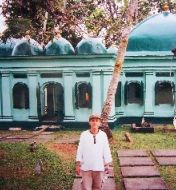
eSa @ 'Green Grave' Complex
Truth to be told, I was actually almost brought to tears when such warmth and friendliness was extended to us… strangers from no where… and being greeted in such manner by the islanders. And this was especially true with the kids of this tiny island. Lovely, beautiful souls of the island. Erm. I sound a bit melancholic and sentimental now, am I not? Well… blame it on RIAU:)
We continued exploring the island and visited some ancient masoleums of significant personalities of the Riau Malay kingdom, ie Engku Puteri and Haji Ali. We also ventured into old palaces of Engku Puteri and Engku Bilik. According to the locals, ‘Penyengat Island’ was actually a ‘wedding gift’ by Sultan Mahmud to his bride Engku Puteri who was the daughter of Raja Ali Haji. Ermmm… how romantic.

One of the many old & abandoned palaces & villas found scattered on the tiny island of Penyengat. This one belonged to Engku Bilik - an inlfuential figure of the by-gone 'Golden-Era' of RIAU Malay Kingdom
Since then, Penyengat Island had become THE centre of government, tradition, Islamic religion and Malay culture. Indeed, Bintan and Penyengat islands have been known among the dwellers of the Malay Archipelago region as the ‘doorstep of history’.
The famous Arab explorer who was known as the ‘Arabian Marco Polo’ – Ibn Battuta – had been claimed to have said “Here there are little islands, from which armed black pirates emerged, possessing armed warships; they plunder people BUT do not enslave them” when referring to the islands of Riau Archipelago.

Stairs leading to an old palace on Penyengat Island
“Tanah air tinggal airnya, Kolong berserakan, Singapura timbul, Singkep tenggelam…”. Loosely translated : ‘ The land (island) is left only with water (and no land/soil on sight), the hollow cavings are scattered all over the place, Singapore risen, while Singkep is sinking…’ . This poetic statement by a blogger named Socrates aptly described the next island that we visited, Singkep Island.

Possibly, the longest jetty in the Malay Archipelago region: Jetty of Singkep Island
Singkep is located at the most end of the Riau Archipelago region. So, I did fulfill a promise to myself of wanting to venture right to the end of the archipelago… and maybe to go even beyond that.
The boat trip to Dabo, Singkep island itself was truly an awesome experience.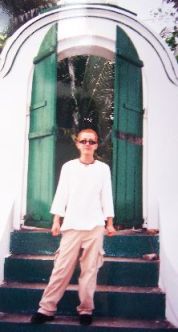 Almost magical, indeed! Almost immediately after the boat left Tanjung Pinang, we were confronted with awesome views of numerous islands, mountain peaks peeking out of the clouds, lonely ‘kelongs’ (fishing huts on pillars) rose from the calm and shallow sea, small huts and houses scattered along the waterside… but most awesomely was the fuzzy contours of Daik Mountain which begun to appear as the boat was approaching the Lingga Island. Immortalised by the Malay in their famous poems of ‘Gunung Daik Bercabang Tiga’ (Daik Mountain with its 3 sharp peaks), the mountain has served as the symbol of strenght and durability for the Malays since aeons ago.
Almost magical, indeed! Almost immediately after the boat left Tanjung Pinang, we were confronted with awesome views of numerous islands, mountain peaks peeking out of the clouds, lonely ‘kelongs’ (fishing huts on pillars) rose from the calm and shallow sea, small huts and houses scattered along the waterside… but most awesomely was the fuzzy contours of Daik Mountain which begun to appear as the boat was approaching the Lingga Island. Immortalised by the Malay in their famous poems of ‘Gunung Daik Bercabang Tiga’ (Daik Mountain with its 3 sharp peaks), the mountain has served as the symbol of strenght and durability for the Malays since aeons ago.
Sadly, though, when we arrived at Singkep Island, we almost immediately realised that this was a very sad place, indeed. When we asked around, one local had even answered us by comparing the present condition of the island to a “negeri dilanggar Garuda” ( a land which is left devastated by the attack of a ‘Garuda’ – a mythical giant bird ).
Indeed. The small Singkep Island was full of holes! Deep, hollow holes. These horrible environmental casualty was the result of hundred of years of tin mining activities. And to make things worst, the sand/soil of this tiny island has also been ‘exploited to the hilt’ in the recent years. Not to mention the abuse of the island’s already- very- limited wealth of the forest. Indeed, if Singkep Island is viewed from above, it may well look like as if the island has been ripped apart… savagely! And by night time (yes…we did spend a night on Singkep Island), as early as 8pm, the whole town was turned into a VERY, VERY quiet and eerie looking place! With its ‘extra dimmed’ street lights (they were ‘extremely’ dimmed, somehow, for some unknown reasons … lack of electric supply maybe?) , the town looked like a backdrop of scenes in horror movies! Really sad. Almost tragic.
Well, after all said and written about Singkep Island, let us not too quick to make any judgement, though. In other words, let us not 100% to… Blame It On RIAU.
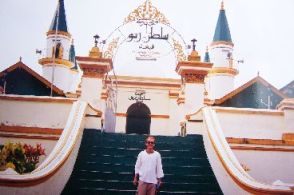
eSa @ Sultan Masjid, Penyengat Island
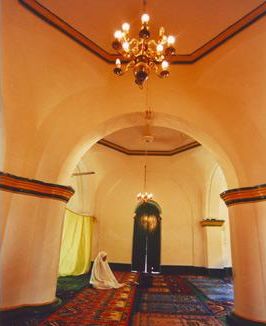
Wishing Malaysians a very MEANINGFUL MERDEKA! And to Muslim readers, ‘RAMADHAN AL MUBARAK!’…

The strecth of beautiful white sand on Li Pe
My quest for the legendary & mythical ancient Malay kingdom of ‘Langkasuka’ next took me to another fascinating place. An ‘eden‘! A long-lost- and- only- now- newly found paradise! A small, immensely beautiful island called Li Pe. But my journey to this heavenly place had almost turned into a ‘nightmare’ …one that I would remember for a very long, long time…indeed.

A 'sampan' in the sea @ Li Pe
The eventful day started beautifully. It was sunny and bright when I took a ‘tuk-tuk’ from Pra Ae to the pier in LANTA town. And as scheduled, the ferry to Li Pe left Lanta sharp at 11 am. I was happy. Indeed, everything was so ‘honky-dory’ that I truly enjoyed the ferry ride till that moment…

2 Chao Lye (Sea Gypsies) kids playing swing on the beach
The ferry stopped at Koh Mok, and then again at Pak Bara (Satun) taking more passengers. I was later transferred to a smaller boat – more like a speed boat, really – in order to continue my journey to Li Pe. Luckily, the boat was almost half-empty. And I was the only Asian passengers, the rest being Europeans and a few Australians.

The beach-front chalet where I stayed @ Pattaya Beach, Li Pe
It started to rain when the boat left Pak Bara jetty. It was windy. Indeed, the wind was getting stronger as the boat went into the open sea. Not long after, the wind and rain became more forceful. I could see from the side of my window that the waves were as high as the boat itself! But the boat kept on moving forward.

View from the chalet's verandah
Now there was no more land or any island in sight. The sea was also cleared of any other sea-vessel. I was getting worried. The boat was rocked fiercely by the becoming-stronger waves. I could see panic and frightened look on other passengers faces, especially mothers with young children. Some of the kids started to cry. And one particular lady seated 2 rows behind me was crying while holding her 2 children.

Me in my newly found 'paradise'...
There were times when the boat felt as if it was about to be overturned by those choppy gigantic waves! Nevertheless, amidst all the suspense and confusion, the boat rode strongly cutting through the waves. When the boat fiinally approached Li Pe island and the rain and wind had subsided, I thanked GOD that we had safely reached our destination.
And what a destination it was! It looked like as if we had stumbled upon a long-lost paradise after braving a deadly storm! Just look at these pictures… Li Pe is truly a gem in the Andaman Sea. If you have the means & time, I would strongly recommend you to visit this paradise island before it turns into another Phuket, Pattaya, Langkawi, Pangkor or even Sa Moi!

Kids at Chao Lye village in Li Pe
QUICK FACTS of LI PE
Ferries –
frm Langkawi (Malaysia): depart from Telaga Harbor/twice a day- from November to May/ other months – only on weekends/ 1 hr ride
frm Pak Bara (Satun): daily – all year round
frm Lanta: daily – from November to May only.
NO jetty/pier at Li Pe – the local Chao Ley will fetch passengers with longtailboats from the ferry/boat and take them to the beach. Be ready to wade the knee-deep water before reaching the beach. Fee: about 50 BHT.
NO ATM on the island, but some resorts and chalets do accept credit cards.
NO cars on the island, except for a few motorbikes. So, people go around by walking! Good for YOU! By the way, Li Pe is such a small island (about 2 – 3 km wide) that you can do a full tour of the island in less than 2 hours!
 3 main beaches:
3 main beaches:
1) Pattaya Beach – the most popular
2) Sunset – the smallest
3) Sunrise – has small Chao Ley village
No…obviously I couldnt find even traces of that legendary and almost mythical ancient Malay Kindom of Langkasuka. Well…some scholars claimed that the kingdom was located on the east-coast of Southern Thailand (ie in the vicinity of Songkhla), while another group believe it was located on the west-coast (ie in Kedah, Malaysia). Its like… well… looking for an ‘Eden in the East’…!

Captivating sunset viewed from Lanta beach
Hmmm…maybe they were ALL right? Being such a great & majestic kingdom of its time…maybe the kingdom was indeed located all the way from the most southern part of the Isthmus of Kra (that slim piece of land that separates South China Sea on the east from Andaman Sea on the west) stretching to the south right until Perlis, Kedah & Kelantan (the most northern states of Malaysia)? Hmmm…as always…me & my wild guesses:)
Anyway, on my ‘island-hopping-trip’ on the Andaman Sea, I came upon this beautiful place called…LANTA. So what if I didnt find a trace of Langkasuka?…at least I stumbled upon a lovely island which bears a name similar (well…only half of the name anyway) to that legendary kingdom. I was happy enough:)
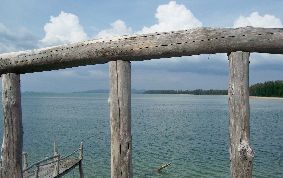
The calm sea viewed from the traditional jetty of Lanta
My ‘island-happy-hopping’ trip began in Krabi. After 3 nights in Krabi, I hopped into a boat that took me to Phi-Phi. Another 2 nights in that ‘tsunami-surviving’ island and then again I found myself on another boat that took me to Lanta. 3 nights in Lanta brought me to many beautiful, laidback, almost ‘tourist-free’ places on this lovely island.
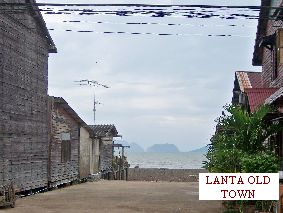
A narrow lane in between wooden shops in Lanta Old Town
The old name for Lanta was ‘Pulau Satak’. And that is ‘Satak Island’ in Malay. Yes, Lanta’s population consist of about 80% Malays. Anyway, the old name was later changed to ‘Lantas’ and finally in 1917 it was renamed ‘Lanta’.
There are actually 2 main islands in Lanta: Lanta Noi & Lanta Yai. The one that I went to was Lanta Yai.
Just a word of advice: if you are planning to go there (Lanta Yai) by taking the land route, just be prepared to spend sometime to board… not 1… but 2 ferries! The 1st one is from the main land (at Baan Hua Hin) and the 2nd one is to cross the small channel from Lanta Noi to Lanta Yai. At least that how it was a year ago.

Hard working Malay women of Lanta
Lanta was first populated by Sea Gypsies or locally called ‘Chao Lay’. They were believed to be originated from Aceh, Indonesia. That was 500 years ago. Then about 200 years ago, the island saw the emerging of Muslim community who came from the south, ie Malaysia and Indonesia. And finally, the Chinese made their way to island about 100 years later.

Me infront of a small 'boutique cafe' in Lanta Old Town
The ‘Chao Lay’ or Sea Gypsies formally lived a semi-nomadic lifestyle. The whole of Andaman Sea was their ‘home’. One interesting aspect that I managed to observe about the ‘Chao Lay’ is their passion in entertainment: a popular folk-dance called ‘Ronggeng’. This is actually also (eventhough not popular now like how it was before) one of the traditional dance in Malaysia! Another fascinating factor that I observed was that the popular local dishes of the islanders are ‘Massaman Curry’ and ‘Chicken Biryani’! Yes indeed, I felt so at ‘home’ on this lovely, lovely island!

Nice way to relax after a full-day of exploring Lanta Island

Could they be the descendants of the legendary & almost mythical ancient Malay Kingdom of Langkasuka...?
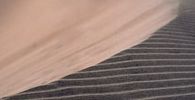
'Desert' of South East Asia
Impossible? Ridiculous? I absolutely could not believe my ears when I first heard about it. Yeah, I had never known that a place like a ‘Sahara’ desert could even exist in humid, tropical condition of the Malay Archipelago region. Well, there is such a place indeed, and it is located in Java.
When I was planning a trip to the ‘Golden Triangle’ of Java, Bandung-Jogya-Surabaya, I had never came across any info, articles or even photos related to this phenomenal site. It was only when I was browsing for some brochures at a travel kiosk in downtown Jogya when I happened to see a brief write-up of this sand dune site. I then made up my mind to go and check-out the place on the very next day!
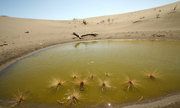
The dreamy little 'oasis' of Parangkusumo
I took a trishaw from my bungalow-hotel and went to the Umbulharjo Bus Station. Actually the bus station was located quite a distance from where I was staying, but the trishaw rider seemed to know short-cut routes which took us through some residential areas. He eventually didn’t even take the trishaw on to the main road at all! But then again, it must had been a very tiring trip for him for that day… God bless him!

Soul searching under the sizzling sunset
The bus I took was destined to go to Parangtritis, the most popular beach in Jogya area. A beautiful beach which is legendarily linked to the mysterious legend of ‘Queen of South’, the ‘Ratu Kidul’. Together with her confidante, the feared ‘Nyi Roro Kidul’, the ever youthful and beautiful Queen, ‘Ratu Kidul’, reigns over the sea nymphs and spirits of the seas around Java!

The soft, smooth, mobile sand dunes of Parangkusumo
Whoaaaa… and how did I get to know about these fantastic tales? Of course, from my other fellow passengers in the bus! Me, being my usual self, could not help but to strike conversations with those who seated close to me. Lo and behold! These people were so friendly and welcoming that they were more than happy to relay to me interesting stories of Parangtritis, Ratu Kidul and all:)
They even advised me not to put on any green color clothes when I visit the beach. Why? That they did not really tell me. But it was simply enough for me to understand when one of them said its for some sort of showing respects to this mystical site. Luckily, I was not wearing any clothing with any slight hint of green color on that day! But then again, honestly, these people were really very, very sweet…

The One & Only Sand Dunes in the Malay Archipelago!
Parangtritis Beach is about 35 km to the south of Jogya. I didn’t really feel the time passed while I was journeying on that bus because as you would’ve already known by now I was busy being entertained by those stories told by my fellow passengers.
Indeed, it was one of them who shouted to the Bus Driver to stop the bus at the entrance of the Parangkusumo Beach. I was at that time still happily ‘yapping-away’ with some old women talking about the Queen and of her legendary love stories.

Slide & Ride the Dunes!
Now, Parangkusumo is actually located on the western section of Parangtritis Beach, about 1 km away from the beach. So, if one travels from Jogya City, one would actually have to pass by this beach (Parangkusumo) before reaching Parangtritis.
Parangkusumo is believed to be the meeting place of 2 mighty rulers: that of the sea ( Ratu Kidul) and of the land (her spouses-Kings of the majestic Mataram Dynasty). By the time I got down from the bus, I was getting so overtly excited already!
The images one would normally have of beautiful beaches anywhere in the world are somehow almost similar… rocky cliffs, sand hit regularly by rolling waves under a clean blue sky and if one is lucky enough, one can also see some coconut trees swayed gently by cool sea-breeze. Now… not all beaches, however, have a unique ‘look’, and not to mention ‘tales’ behind them. One of the few that does is definitely Parangkusumo Beach!
Upon entering the Parangkusumo Beach, I immediately felt the ‘sacred’ nuances of the place. The smell of the fragrance of flowers and incense filled up the air. Well, it did gave me a bit of ‘goose-bumps’ in the beginning… and then, I saw it! Right infront of me. The magical and mystical sight of the Parangkusumo Sand Dunes. Breathtaking! Hypnotizing! Mesmerising! Whoa!

The magical & mystical sand dune of Parangkusumo
I had lived in the Middle East for almost 8 years and normally the sight of dunes or desert-like places would not make me shout ‘WHOA!’ anymore. But this… the one in Parangkusumo… this is really an ‘out-of the world’ experience. It was …hmmm… seemed to be so surreal. Magical. Yeah, of course, mystical too. Well…at least that was how I felt. But I guess I was not that wrong though… because then I came to know that the site has indeed been listed as a ‘World Heritage’ site, as one could read from a signboard placed at the entrance to the beach.

Parangtritis Beach is in the background. The 'Nyi Roro Kidul' cave is located not far from here.
Parangkusumo Sand Dunes are actually lumps of sand that are 20m above sea level. This is THE only sand dunes in the South East Asia, or to be more precise, in the Malay Archipelago region. It is indeed an extraordinarily rare phenomenon in the humid tropical region.
Back to the ‘Ratu Kidul’ story, it is believed that Parangkusumo was where Parembahan Senopati, the 1st legendary ruler of the Javanese Mataram Dynasty received a divine revelation. Here at Parangkusumo he made an agreement with ‘Ratu Kidul’, where the Queen would always protect the Kings of Mataram and its people. In return, the Queen was (and still ‘is’… some peoplewould say!) spiritually married off to EVERY King of the Mataram Dynasty. Whoa! WHOA! WHOA!!!
So, every year, even in this present time, on the 30th day of the Javanese month, called ‘Rejeb’, offerings to the ‘Ratu Kidul’ the Queen of the South Sea are held at Parangkusumo beach. The offerings are cast into the sea in the hope that the Kings and people of Java will have continuous peace and prosperity. Hmmm… I love legends. And the Malay Archipelago region is loaded with exotic, very ‘dreamy’ beautiful places with great legends.
TRULY AWESOME!!!
During my brief stay in Pekan recently, my Uncle (thanks, Luke!) took me to a very small village which was occupied by the Aboriginal people. Yes… the ‘Orang Asal’ (literally translated as ‘original people’) village. A sub-group of the many groups of the indigenous people of the Malay Archipelago region.
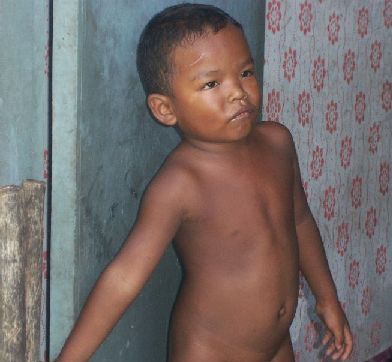
An 'Orang Asal' boy
Very interesting. Very engaging experience for me. And, yes, they were (the ‘Orang Asal’ people) really, really very shy, humble and yet absolutely friendly and welcoming.
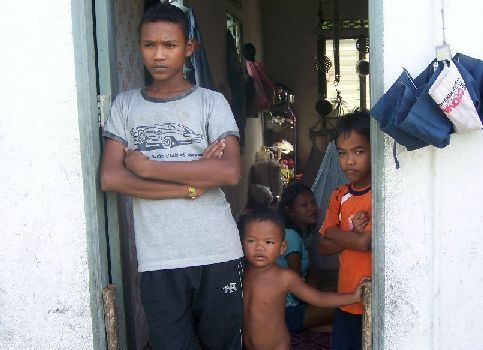
The 'Orang Asal' boy and family
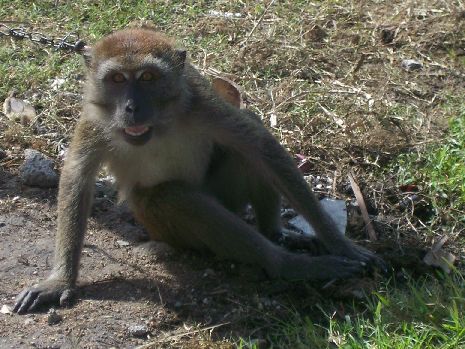
A pet-monkey belongs to the 'Orang Asal' family
Frankly speaking, that was my very ‘first-hand’ experience with them. But, you bet, it would definitely not going to be my last one. From that moment, I had made a promise to myself that I would definitely like to be with and around them more often in the future. Those genuine smile… those sparkling sincere eyes… those gentle gestures… there were so… very original! Very ‘Asal’!

A calm, beautiful lake by the sea in Pekan
This serene looking lake located just few metres away from the beach of the South China Sea is just one of the many, many beautiful and mesmerising looking spots and sites which can be found in great abundance in and around the Malay Archipelago region. Waterfalls, natural hot springs, islands can easily be found within reach at almost all of the major cities and towns in the region.
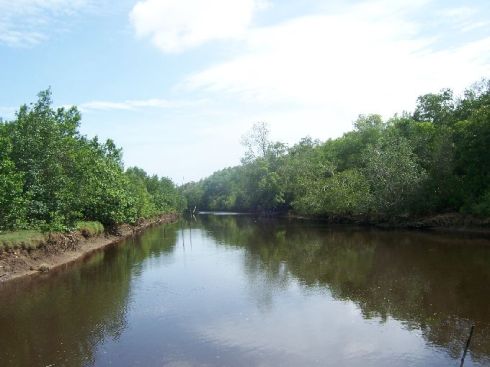
A water-canal in Pekan

Line of Pine Trees by the sea, Pekan

A library building, Pekan
Well… the building is not exactly as ‘hi-tech’ as the PETRONAS Twin Towers in Kuala Lumpur, yet I truly adore this charming structure. I used to come and play at the front of this house when I was small. Back then, it was just a scary looking abandoned big old mansion… the kind of place that remind me of those black & white ‘Frankestein’ movies!

Salted marine products left to be dried-up on the pavement of Pekan town
The Malay Archipelago region is ‘bursting’ with loads and tons of marine and natural traditional products. A truly multi-colored and multi-layered presentations of exotic, unique goods and products… and yet, surprisingly, they are good for one’s soul and friendly to the nature too!
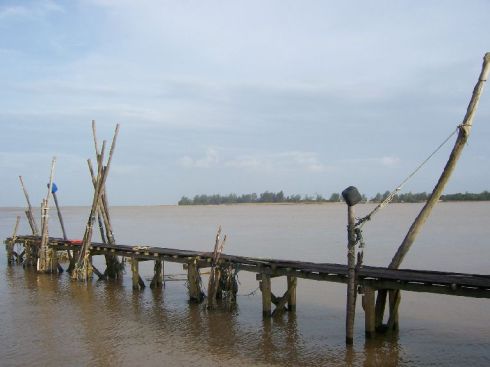
A traditional jetty, Pekan
Where on earth is PEKAN?
Pekan is located on the east-coast part of Peninsular Malaysia. It is about 4 hours drive from Kuala Lumpur.
How to get there?
From Kuala Lumpur, take the Karak Highway and then continue the journey on the East Coast Highway. Exit at Gambang and continue on the trunk road leading to Kuantan town. Take Note: Before reaching Kuantan, look out for ‘Pekan’ signboard. Follow the direction (you need to make a ‘U’ turn and almost right away after that to turn to left) and you will be in Pekan in no time at all.
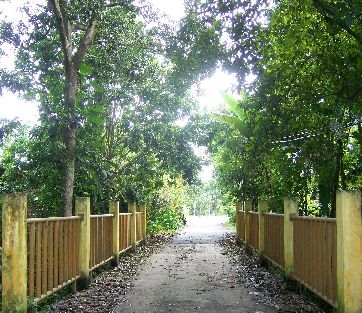
I chose a small town called ‘Pekan’ to be featured in this very 1st post of mine for many reasons. Yeah… mostly they are personal. This is the town where I had spent the first 7 years of my life. My earliest ‘playground’. Indeed, my very first ‘playground’ in the vast region of the Malay Archipelago.
And boy oh boy… I had so many playmates to go around with back then… never mind the fact that they were all my uncles, aunties, cousins, second cousins and so on. In short, they were all, somehow, related to me.
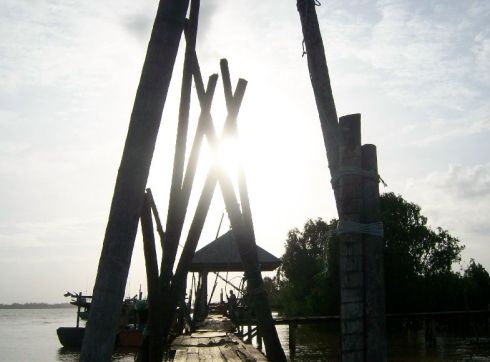
Sunset at a Traditional Jetty, Pekan
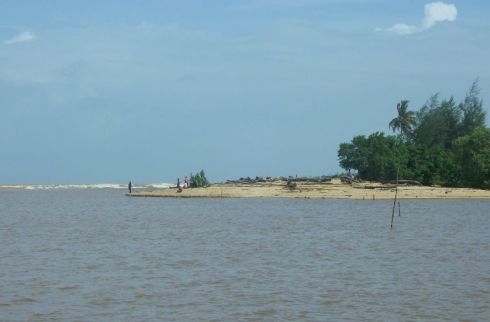
Where the river meets the sea... estuary at Pekan
But that was how it was for almost everyone else in Pekan too, back then. A small charming, serene little ‘cowboy-town’ which was populated mostly by one’s relatives!
I went back to Pekan recently for a brief stay. And… off course… I could no more claim any Mat, Minah and Mail whom I met was my uncle, auntie or cousin.
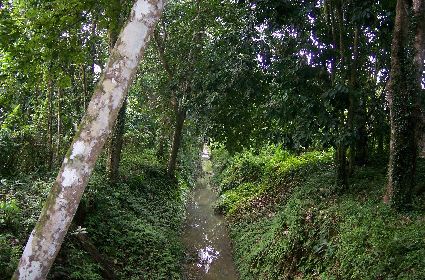
A serene looking drain that runs through a village in Pekan
These two pictures here are examples of the many, many beautiful sites found in and around the Malay Archipelago region. The region showcases hundreds of exotic spots like waterfalls, natural hot springs, islands, beaches, highlands and many many more. Heavenly good retreat sites for one’s soul!
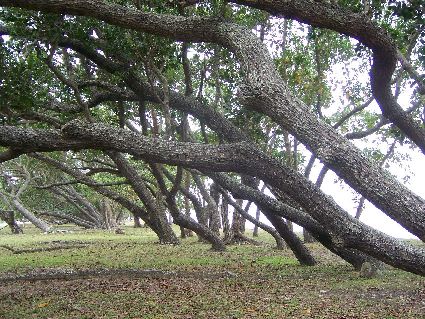
'Bow-Down' trees at a beach in Pekan
In short, there are many, many more people in Pekan now. And many, many of these many, many people originally come from other parts of Malaysia (or even … from other countries!).
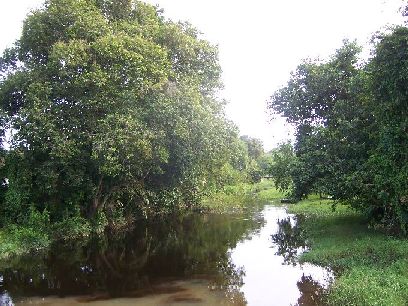
A water-canal in Pekan
Parts of Pekan town have also gone through some changes and developments. I guess it is for the sake of improving lives and economy of the residents. Very noble intention, indeed. But I was getting a little bit worried if the rustic charm of the ‘old’ Pekan would eventually be ‘sacrificed’ in the name of progress and modernisation.
I re-visited some of my ‘all-time-favourite-spots’ in and around Pekan. I was relieved to see that most parts of these sites were left quite ‘untouched’ .
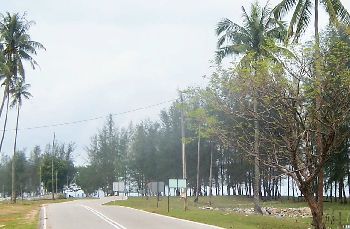
A road by the sea, Pekan
And while I was there, almost immediately, I was taken back to the time when I was still very small, running around and abound accompanied by my many, many uncles, aunties, cousins, second cousins and so on. Awesome!
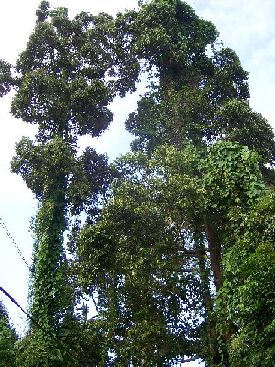
The 'Twin Towers' of Pekan
I stumbled upon these two very tall trees in a village called ‘Parit’ in Pekan. They reminded me of those ‘other’ tall structures back in the city… the PETRONAS Twin Towers 🙂
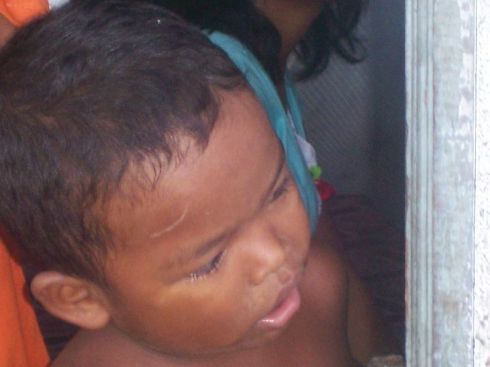
An 'Orang Asal' (Aborigine) Boy
Where on earth is PEKAN?
Pekan is located on the east-coast part of Peninsular Malaysia. It is about 4 hours drive from Kuala Lumpur.
How to get there?
From Kuala Lumpur, take the Karak Highway and then continue the journey on the East Coast Highway. Exit at Gambang and continue on the trunk road leading to Kuantan town. Take Note: Before reaching Kuantan, look out for ‘Pekan’ signboard. Follow the direction (you need to make a ‘U’ turn and almost right away after that to turn to left) and you will be in Pekan in no time at all.

- Me and ‘Mini Tsunami’

